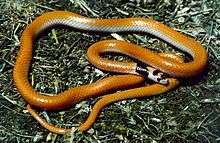Black-headed ground snake
| Black-headed ground snake | |
|---|---|
 | |
| Adult male Rhynchocalamus melanocephalus satunini from Armenia | |
| Scientific classification | |
| Kingdom: | Animalia |
| Phylum: | Chordata |
| Class: | Reptilia |
| Order: | Squamata |
| Suborder: | Serpentes |
| Family: | Colubridae |
| Genus: | Rhynchocalamus |
| Species: | R. melanocephalus |
| Binomial name | |
| Rhynchocalamus melanocephalus Jan, 1862 | |
| Synonyms | |
- Common names: black-headed ground snake, Palestine kukri snake
The black-headed ground snake (Rhynchocalamus melanocephalus) is a species of small and elegant harmless snake, which is endemic to the Eastern Mediterranean and the Near East. It belongs to the Colubridae family. Two subspecies, Rhynchocalamus melanocephalus melanocephalus and Rhynchocalamus melanocephalus satunini, are currently recognized.
Description
The black-headed ground snake is a small, burrowing snake with a slender body reaching just 36–40 cm (14–16 in) in total length (body + tail). Its smooth and shiny dorsal scales and almost transparent covering make many of its internal organs quite visible, when observed against a light source.[3] The eyes are small, with black irises. The head is covered with symmetrical large shields. The rostral shield is somewhat enlarged and specialized for digging through soil. The dorsal coloration may vary from tan to orange, with no obvious pattern except on the neck and head. The belly is clear white.
The pattern on the neck and head is different in the two subspecies. In the nominate subspecies, Rhynchocalamus melanocephalus melanocephalus, there is no separation between the neck pattern and the head pattern. The upper surface of the head and neck is ash-black. Only the labials, the nasals, and the rostal are white. In R. melanocephalus satunini the neck carries a black semi-collar, and the head pattern consists of three transverse black saddles. The first one is on the rostral. The second spreads over the postnasal, supraorbital, and frontal, and partially over the prefrontal shields from eye to eye. The third saddle covers the parietal shields and some of the surrounding scales. The spaces between the black saddles are white, which makes Rhynchocalamus visually identifiable from similar looking species of the genera Eirenis and Pseudocyclophis, which often occupy the same habitat.
Natural history
Very little is known about the natural history of the black-headed ground snake. This burrowing species spends most of its life underground, and depends heavily on the soil humidity.[3] It can be found only rarely, mainly under rocks, or extremely rarely on the surface after heavy rains in late spring and early summer.[3]
Diet
This little predator forages on larvae and eggs of ants, and possibly other invertebrates.
Geographic range
This snake is known from dry shrublands of the Eastern Mediterranean and Near Eastern countries. There are records from Armenia, Azerbaijan, Israel, Iran, Iraq, Jordan, Lebanon, Palestine, Saudi Arabia, Syria, and Turkey. The southern part of its range is occupied by the nominotypical subspecies, Rhynchocalamus melanocephalus melanocephalus Jan, 1862. Populations from Armenia, Azerbaijan, northeastern Turkey, and northwestern Iran form the subspecies, Rhynchocalamus melanocephalus satunini Nikolsky, 1899.
Habitats and ecology
This snake is known from rocky, clayey semideserts. It spends most of its time underground, and rarely may be found under rocks after heavy rains in spring and early summer.
Land use and protection
Habitats of the black-headed ground snake have been largely irrigated or transformed into urban areas. Also, in many places, semidesert is being used as pasture for domestic goats, sheep, and cattle.
Conservation status
This species is classified as Least Concern (LC) according to the IUCN Red List of Threatened Species, but was included in the Red Lists of Armenia, Azerbaijan, and the former USSR as an extremely rare species.
References
- ↑ McDiarmid RW, Campbell JA, Touré T. 1999. Snake Species of the World: A Taxonomic and Geographic Reference, Volume 1. Washington, District of Columbia: Herpetologists' League. 511 pp. ISBN 1-893777-00-6 (series). ISBN 1-893777-01-4 (volume).
- ↑ The Reptile Database. www.reptile-database.org.
- 1 2 3 The Team of Authors (2006). Ayvazyan HM; Aleksanyan GV; Aloyan PG; Aghamalyan FM; Armaghanyan SS; Baloyan SA; Gabrielyan EC; Tadevosyan TL; Khachatryan HM; Khoyecyan AV; Mkrtchyan RS; Mnacakanyan BP; Yavruyan EG; Nanagulyan SG; Poghosyan VKh., eds. Natural World of Armenia. Yerevan: Armenian Encyclopedia. p. 691. ISBN 5-89700-029-8.
Further reading
- Aghasyan AL. 1996. [The Fauna of Snakes of Armenia and Nakhichevan]. Yerevan: PhD Thesis. 34 pp.(in Russian).
- Ananjeva NB, Borkin LYa, Darevsky IS, Orlov NL, 1998. [Encyclopedia of Russian Nature: Amphibians and Reptiles]. Moscow: ABF Publishing. 351 pp. (in Russian).
- Ananjeva, NB, Orlov NL, Khalikov RG, Darevsky IS, Rjabov SA, Barabanov AV. 2004. [Atlas of Reptiles of Northern Eurasia]. St. Petersburg, Russia: "Ivan Fedorov" Print. 230 pp. (in Russian).
- Arakelyan MS, Danielyan FD, Corti C, Sindaco R, Leviton AE. 2011. Herpetofauna of Armenia and Nagorno-Karabakh. Oxford, Ohio: Society for the Study of Amphibians and Reptiles. ISBN 978-0-916984-84-7.
- Boulenger GA. 1894. Catalogue of the Snakes in the British Museum (Natural History). Volume II., Containing the Conclusion of the Colubridæ Aglyphæ. London: Trustees of the British Museum (Natural History). (Taylor and Francis, printers). xi + 377 pp. + Plates I.- XX. (Oligodon melanocephalus, p. 246).
- Darevsky IS. 1957. [The Fauna of Reptiles of Armenia and Its Zoogeographical Analysis]. Yerevan: PhD Thesis. 468 pp. (in Russian).
- Darevsky IS. 1970. "Systematic status of Rhynchocalamus melanocephalus satunini Nik. (Serpentes, Colubridae) previously included in the genus Oligodon". Zool. Zhurnal 49: 1685-1690.
- Jan G. 1862. "Enumerazione sistematica delle specie d'ofidi del gruppo Calamaridae". Archivio per la zoologia l'anatomia e la fisiologia 2: 1-76. (Homalosoma melanocephalum, p. 54). (in Italian).
- Jan G. 1865. Iconographie générale des ophidiens. Treizième livraison. Paris: J-B Baillière. Index + Plates I- VI. (Homalosoma melanocephalum, Plate III, Figures 4 & 4a). (in French).
External links
- Rhynchocalamus melanocephalus at the Reptarium.cz Reptile Database. Accessed 2 September 2007.
- Rhynchocalamus melanocephalus at Tadevosyan's Herpetological Resources. Accessed 20 January 2007.
